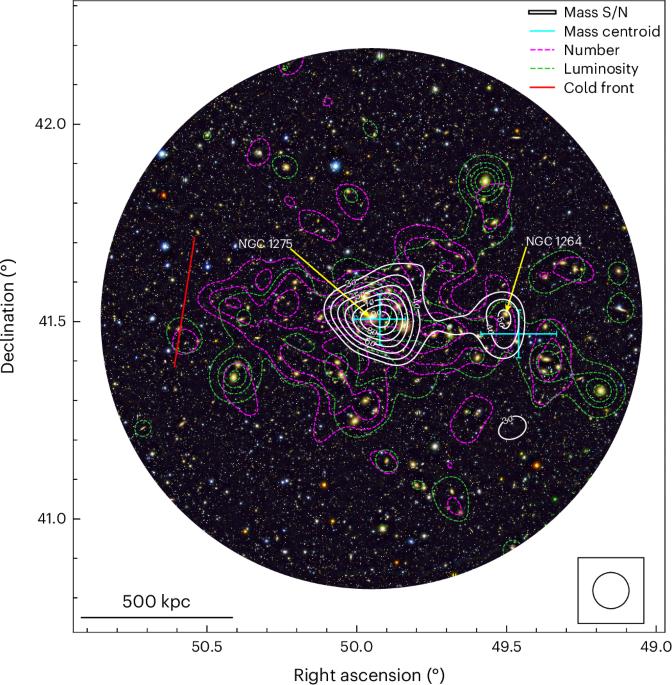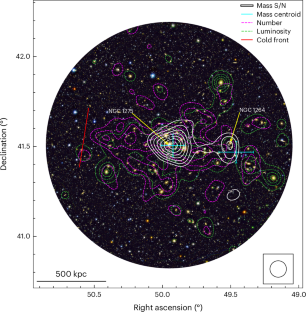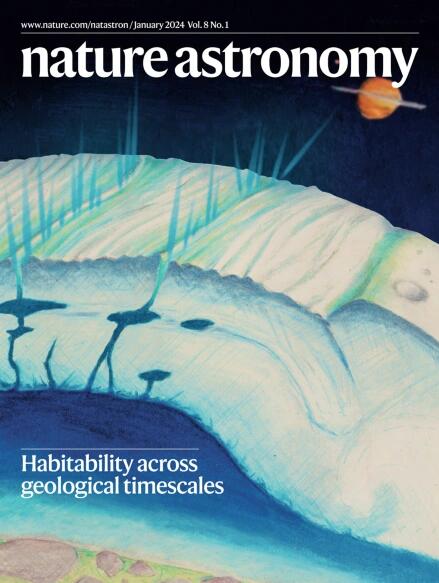英仙座星团发生重大合并的直接证据
IF 14.3
1区 物理与天体物理
Q1 ASTRONOMY & ASTROPHYSICS
引用次数: 0
摘要
虽然英仙座星系团经常被认为是一个典型的松弛星系团,但一些证据,包括古老的、大规模的冷锋、不对称的等离子体形态、丝状星系分布等,提供了一个相互矛盾的动态观点,表明该星系团可能经历了一次大的合并。然而,到目前为止,还没有发现一个明确的合并伴星,这阻碍了我们对英仙座星团进化轨迹的理解,与这些观测特征相一致。在这里,通过仔细的弱透镜分析,我们成功地确定了位于英仙座主星团核心以西430 kpc的NGC 1264中心的>5σ级缺失的子星团晕(总质量\({M}_{200}={1.70}_{-0.59}^{+0.73}\times {10}^{14}\,{M}_{\odot }\))。此外,在英仙座主星系团和子星系团之间还发现了一个显著的(>3σ)质量桥,这也是引力相互作用的直接证据。通过理想化的数值模拟,我们证明了3:1的离轴大合并可以在主星团核心以东700 kpc处产生观测到的冷锋,并通过多个核心交叉点产生观测到的质量桥。这一发现解决了英仙座动力学状态的长期难题。本文章由计算机程序翻译,如有差异,请以英文原文为准。


Direct evidence of a major merger in the Perseus cluster
Although the Perseus cluster has often been regarded as an archetypical relaxed galaxy cluster, several lines of evidence, including ancient, large-scale cold fronts, asymmetric plasma morphology, filamentary galaxy distribution and so on, provide a conflicting view of its dynamical state, suggesting that the cluster might have experienced a major merger. However, the absence of a clear merging companion identified so far hampers our understanding of the evolutionary track of the Perseus cluster consistent with these observational features. Here, through careful weak-lensing analysis, we successfully identified the missing subcluster halo (total mass $${M}_{200}={1.70}_{-0.59}^{+0.73}\times {10}^{14}\,{M}_{\odot }$$ ) at the >5σ level centred on NGC 1264, which is located ~430 kpc west of the Perseus main cluster core. Moreover, a significant (>3σ) mass bridge, which is also traced by the cluster member galaxies, is detected between the Perseus main and subclusters, which serves as direct evidence of gravitational interaction. With idealized numerical simulations, we demonstrate that an ~3:1 off-axis major merger can create the cold front observed ~700 kpc east of the main cluster core and generate the observed mass bridge through multiple core crossings. This discovery resolves the long-standing puzzle of Perseus’s dynamical state. The identification via weak lensing of a subcluster halo, connected to the galaxy cluster Perseus by a mass bridge, provides direct evidence of a past major merger, reshaping our understanding of Perseus’s dynamical history.
求助全文
通过发布文献求助,成功后即可免费获取论文全文。
去求助
来源期刊

Nature Astronomy
Physics and Astronomy-Astronomy and Astrophysics
CiteScore
19.50
自引率
2.80%
发文量
252
期刊介绍:
Nature Astronomy, the oldest science, has played a significant role in the history of Nature. Throughout the years, pioneering discoveries such as the first quasar, exoplanet, and understanding of spiral nebulae have been reported in the journal. With the introduction of Nature Astronomy, the field now receives expanded coverage, welcoming research in astronomy, astrophysics, and planetary science. The primary objective is to encourage closer collaboration among researchers in these related areas.
Similar to other journals under the Nature brand, Nature Astronomy boasts a devoted team of professional editors, ensuring fairness and rigorous peer-review processes. The journal maintains high standards in copy-editing and production, ensuring timely publication and editorial independence.
In addition to original research, Nature Astronomy publishes a wide range of content, including Comments, Reviews, News and Views, Features, and Correspondence. This diverse collection covers various disciplines within astronomy and includes contributions from a diverse range of voices.
 求助内容:
求助内容: 应助结果提醒方式:
应助结果提醒方式:


